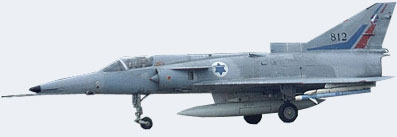IAI Kfir
 Israel Aircraft Industries Kfir is an Israeli-built all-weather, multi-role combat aircraft based on a modified Dassault Mirage 5 airframe, with Israeli avionics and an Israeli-made version of the General Electric J79 turbojet engine.The IAI Kfir is one of the best known examples of the developmental approach to the design and construction of combat aircraft, which consists in the modernization of well-proven airframes to face the challenges posed by an increasingly sophisticated air-combat environment.The project that would ultimately give birth to the Kfir can be traced back to Israel's need for adapting the Dassault Mirage IIIC to the specific requirements of the Israeli Air Force (IAF).
Israel Aircraft Industries Kfir is an Israeli-built all-weather, multi-role combat aircraft based on a modified Dassault Mirage 5 airframe, with Israeli avionics and an Israeli-made version of the General Electric J79 turbojet engine.The IAI Kfir is one of the best known examples of the developmental approach to the design and construction of combat aircraft, which consists in the modernization of well-proven airframes to face the challenges posed by an increasingly sophisticated air-combat environment.The project that would ultimately give birth to the Kfir can be traced back to Israel's need for adapting the Dassault Mirage IIIC to the specific requirements of the Israeli Air Force (IAF).
While the Mirage IIICJ proved to be extremely effective in the air-superiority role, its relatively short range of action imposed some drawbacks to its usefulness as a ground-attack aircraft.
Thus, in the mid-1960s, at the request of Israel, Dassault Aviation began developing the Mirage 5, a fair-weather, ground-attack version of the Mirage III. By 1968, Dassault had finished production of the 50 Mirage 5Js paid for by Israel, but an arms embargo imposed upon this country by the French government in 1967 prevented Dassault from ever delivering the aircraft. The Israelis replied by producing an unlicensed copy of the Mirage 5, the Nesher (Eagle), with technical specifications for both the airframe and the engine obtained by the Israeli intelligence.

In order to accommodate the General Electric J79 powerplant on the Mirage III's airframe, and to deliver the added cooling required by the J79, the aircraft's rear fuselage was slightly shortened and widened, its air intakes were enlarged, and a large air inlet was installed at the base of the fin, so as to supply the extra cooling needed for the afterburner. The engine itself was encased in a titanium heatshield.
When the Kfirs were modified to use small detachable canards and other minor improvements, they were given the name Kfir C.1.
The much improved Kfir C.2, revealed in 1976, was the first full-standard version of the aircraft. Benefiting from the operational experience obtained with the first variant, the C.2 featured delta canard foreplanes mounted on the air intakes, narrow "strakes" along the tip of the nose, and extended "dogtooth" outer wing panels. These aerodynamic modifications gave the Kfir better all-around manoeuvrability, reduced landing and take-off distance, and superior handling at low speeds. All C.2s were also equipped with a Martin-Baker Mk.10 ejection seat, and seven weapons pylons.
In 1983, IAI began to upgrade the Kfir C.2s/TC.2s to a new variant, the Kfir C.7/TC.7, which carried a modified version of the J79-GE-17E powerplant, with an additional 4.45 kN (1,000 lb st) of afterburning thrust, and an enhanced thrust-to-weight ratio. The Kfir C.7 featured a modernized HOTAS cockpit, with new avionics, including the Elta EL/M-2021B pulse-Doppler radar and the Elta EL/L-8202 advanced electronic jammer, plus guided weapons carrying capability, two additional hardpoints below the intake ducts (for a total of nine), and provision for in-flight refueling. With a maximum take-off weight increased by 1,540 kg (3,395 lb), as well as an improved combat radius, the Kfir C.7 was a much better ground attack aircraft than its predecessor. The emphasis given on the improvement of the strike capabilities of the Kfir signaled the new role assigned to the aircraft in the IAF's order or battle during the 1980s, as the F-15s and F-16s took over the air-superiority and interception missions.
Since the J79 turbojet engine as well as much of the technology inside the Kfir are produced in Israel under U.S. license, all export sales of the Kfir are subject to prior approval from the U.S. State Department, a fact that has limited the sale of the Kfir to foreign nations.
As of 2006, the IAI Kfir has been exported to Colombia, Ecuador, and Sri Lanka. Also, 25 Kfir C.1s were leased to the US Navy and the USMC in the 1980s.
Specifications (Kfir C.2)
Length: 15.65 m (51 ft 4.25 in)
Wingspan: 8.21 m (26 ft 11.5 in)
Height: 4.55 m (14 ft 11.5 in)
Wing area: 34.80 m² (374.60 sq ft)
Empty weight: 7,285 kg (16,060 lb)
Loaded weight: 10,415 kg (22,961 lb)
Max takeoff weight: 14,670 kg (32,340 lb)
Powerplant:
1× IAl Bedek-built General Electric J-79-J1E turbojet
Dry thrust: 52.89 kN (11,890 lb st)
Thrust with afterburner: 83.40 kN (18,750 lb st)
Performance:
Maximum speed: 2,440 km/h (1,516 mph)
Range: 770 km (480 mi)
Service ceiling: 17,700 m (58,000 ft)
Rate of climb: 233.3 m/s (45,930 ft/min)
Armament:
Guns: 2x Rafael-built DEFA 553 30-mm cannons with 140 rounds per gun.
Maximum Ordnance Load: 6,065 kg (13,343 lb)
Bombs: Mk-82, GBU-13 LGB, TAL-1 and TAL-2 CBUs, BLU-107 Durandal, HOBOS.
Unguided rocket launchers
Missiles: Shrike ARMs; Maverick ASMs; Sidewinder, Shafrir, and Python-series AAMs.
Links:
www.israeli-weapons.com
www.globalaircraft.org
www.fas.org
www.acig.org
(Adapted from http://www.wikipedia.org/ )
Labels: aircraft, aviation, canards, Dassault, dreamhost promocode, Durandal, IAI Kfir, Israel Aircraft Industries, Kfir, links, Maverick ASMs, Mirage IIICJ, Nesher, Python, Shafrir, Shrike ARMs, Sidewinder




0 Comments:
Post a Comment
<< Home